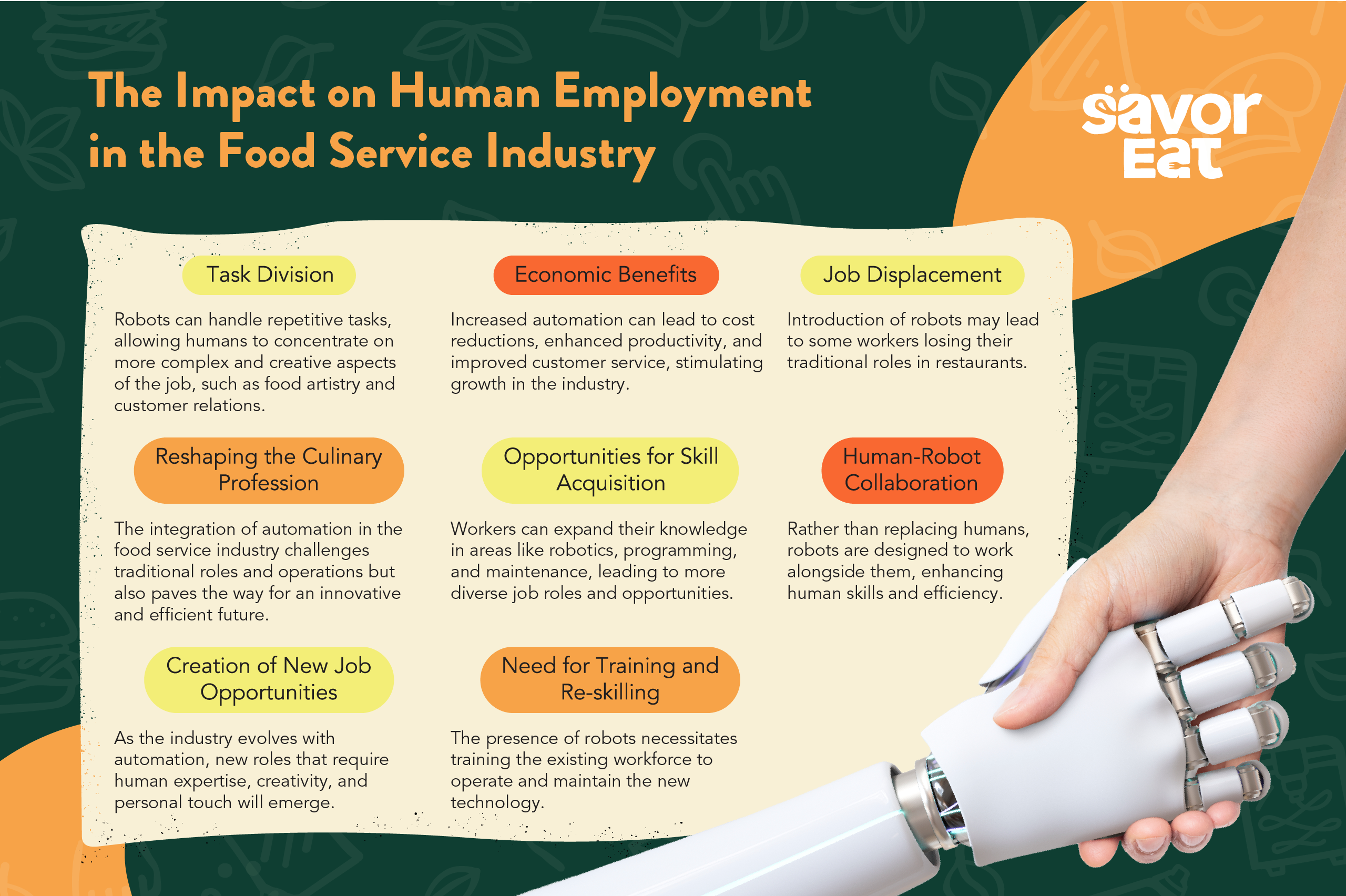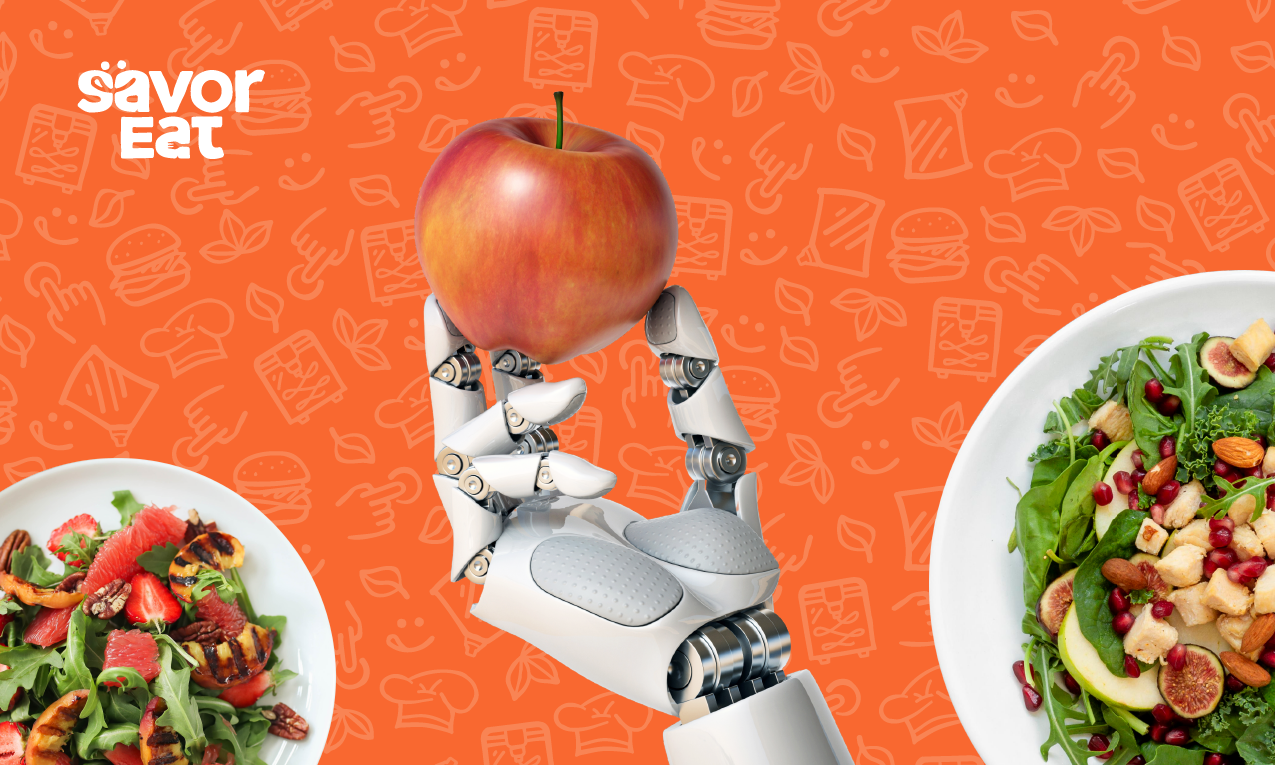Are you prepared to enter a world where robots are not just science fiction but an integral part of the restaurant industry? Fasten your seatbelts as we embark on a journey into the captivating realm of restaurant robotics.
From Miso Robotics’ burger-flipping robot, Flippy, to automated pizza makers, these cutting-edge machines are revolutionizing the way meals are made and served. They are enhancing the diner experience in fast-casual restaurants, streamlining operations, and even addressing labor shortages in the hospitality business.
In this article, we will delve deep into the functionalities and applications of robots in restaurants. We’ll explore how they are reshaping the food sector, from making the food to delivering it to diners. Whether it’s a robotic kitchen system in a new restaurant or a robot waiter at a renowned restaurant chain like Chili’s, these smart machines are making their mark worldwide.
We’ll examine how robots can help automate repetitive tasks, improve efficiency, and even reduce mistakes. From flipping burgers to frying chicken wings, these machines work tirelessly, ensuring consistent food quality. You’ll learn about innovative companies like Bear Robotics and California-based Richtech, who are pioneering new technology in restaurant robotics.
Moreover, we’ll take you into the intriguing world of robot interaction. Here, robots don’t just prepare dishes but also deliver food to customers, take orders at a kiosk, and even travel back and forth to the kitchen. We’ll highlight how robots, like China-based Pudu Robotics’ Servi, can navigate tables and greet customers, adding a futuristic touch to the restaurant experience.
Additionally, we’ll discuss how the use of robots is transforming restaurant operations, increasing productivity, and even addressing the industry-wide labor shortage. We’ll also tackle the sensitive issue of robots potentially replacing human servers. Can AI-powered machines coexist with restaurant workers, or will they render them obsolete?
Finally, we’ll ponder the future of the culinary profession in this age of automation. From the National Restaurant Association’s stance on using robotics to Buffalo Wild Wings’ trial of Flippy 2, a new version of the burger-flipping robot, we’ll explore the impact of robots on the restaurant business.
Whether it’s a robotic kitchen at Spyce, a fast-casual restaurant in the U.S., or a salad-making robot at Wilkinson Baking Company, the future of dining is here. Let’s dive into this exciting new era together!
The Role of Restaurant Robots in Meal Preparation
Let’s dive into the fascinating world of restaurant robots and explore how they’re revolutionizing meal preparation!
One of the key roles of restaurant robots is automating food preparation, which brings a whole new level of efficiency to kitchen operations. These robots are designed to handle repetitive tasks that would otherwise require human intervention, such as burger-making, bread-making, and meal assembly. By taking over these tasks, robots not only speed up the process but also improve food quality by ensuring consistency and accuracy in every step.
With their precise movements and programmed routines, restaurant robots are able to create dishes with utmost precision, resulting in a more enjoyable dining experience for customers. Additionally, these robots have the ability to reduce food waste by carefully measuring and portioning ingredients, minimizing the chances of overcooking or undercooking. This not only saves money for the restaurant but also contributes to a more sustainable approach to food preparation.
Moreover, the cost effectiveness of restaurant robots can’t be overlooked. While the initial investment may be significant, the long-term benefits outweigh the costs. Robots can work tirelessly without the need for breaks or rest, allowing for continuous meal preparation and faster turnaround times. This increased efficiency directly translates to higher productivity and, ultimately, increased revenue for the restaurant.
By utilizing restaurant robots, businesses can streamline their operations, optimize their resources, and provide a more seamless dining experience for their customers. As we move forward into the subsequent section about enhancing the dining experience with robot interaction, it’s clear that restaurant robots have become an integral part of the food industry, transforming the way meals are prepared and delivered to the table.
Enhancing the Dining Experience with Robot Interaction
Experience a whole new level of dining with the exciting addition of robot interaction, where these futuristic servers will enhance your mealtime enjoyment. Restaurant robots are revolutionizing the food industry by improving customer satisfaction, enhancing efficiency, personalizing dining experiences, increasing the speed of service, and reducing human errors.
With the introduction of robot servers, you can expect a seamless dining experience where your needs are met with precision and timeliness. These robots are programmed to deliver your food promptly and accurately, ensuring that you receive your order exactly as you desire. Their precise movements and quick response time contribute to a more efficient dining experience, allowing you to enjoy your meal without any unnecessary delays or errors.
By incorporating restaurant robots into the dining experience, establishments are able to streamline operations and increase productivity. With the help of these robots, staff members can focus on other important tasks such as food preparation and customer service, while the robots handle the delivery and serving aspects. This not only saves time but also reduces the risk of human errors that can occur during the hectic rush of mealtime.
With the efficiency and accuracy of robot servers, the overall dining experience is elevated, leaving you with a sense of satisfaction and a desire to return. So, get ready to embark on a dining adventure like no other, where robot interaction enhances your experience and sets the stage for the next section about streamlining operations and increasing productivity.
Streamlining Operations and Increasing Productivity
By incorporating restaurant robots into their operations, establishments can effortlessly streamline tasks and boost productivity, leaving staff members with more time to focus on exceptional customer service and culinary creations that will leave your taste buds craving for more.
These robots are capable of automating processes such as food preparation, dishwashing, and even bussing tables. By taking over these repetitive and time-consuming tasks, robots can significantly reduce the labor required, allowing restaurant staff to allocate their time and energy towards other important aspects of the dining experience.
With the help of robots, efficiency improvements can be achieved, leading to optimized operations and increased output.
Restaurant robots are designed to work seamlessly alongside human employees, complementing their skills and expertise. As robots handle the more mundane and repetitive tasks, staff members are freed up to focus on providing exceptional customer service and creating culinary masterpieces.
The introduction of robots not only increases efficiency but also ensures consistency and accuracy in food preparation and service. With less time spent on manual labor, restaurant employees can dedicate themselves to perfecting their craft and putting their creative touch on each dish.
This integration of robots in the food industry is revolutionizing the way restaurants operate and enhancing the overall dining experience.
Let’s explore the impact of restaurant robots on human employment in the food service industry.
The Impact on Human Employment in the Food Service Industry
The integration of restaurant robots has transformed the food service industry, sparking a fascinating evolution in human employment. While the introduction of robots into restaurants may lead to job displacement for some workers, it also presents new opportunities and workforce implications.
Rather than completely replacing humans, restaurant robots are designed to collaborate with them, working alongside and enhancing their skills. This human-robot collaboration allows for a more efficient and streamlined operation, where robots can handle repetitive and mundane tasks, while humans focus on more complex and creative aspects of food preparation and customer service.
However, the introduction of restaurant robots also calls for training and re-skilling of the existing workforce. As technology advances, workers will need to adapt and learn how to operate and maintain these robots effectively. This presents an opportunity for workers to acquire new skills and expand their knowledge in areas such as robotics, programming, and maintenance.
Additionally, the economic impact of restaurant robots is significant. With increased automation and efficiency, businesses can potentially reduce costs, improve productivity, and provide better services to customers. This can lead to overall growth in the food service industry and create new job opportunities in areas that require human expertise and creativity.
As we delve into the future of the culinary profession in an automated world, it’s crucial to understand how the integration of restaurant robots has reshaped the food service industry.

The Future of the Culinary Profession in an Automated World
In an automated world, the future of the culinary profession is rapidly evolving, with the integration of restaurant robots leading to increased efficiency and productivity. One interesting statistic to emphasize this point is that the use of robotics in the food service industry is projected to grow at a CAGR of 30% from 2021 to 2028. As technology continues to advance, it’s important to consider the implications and opportunities that arise in the culinary field.
The future of culinary education will undoubtedly be influenced by the presence of restaurant robots. As these machines become more prevalent in professional kitchens, culinary schools will need to adapt their curriculum to include training on working alongside and supervising robots. Additionally, there will be a need for specialized courses that focus on programming and maintaining these robots. This shift in education will ensure that future chefs are equipped with the necessary skills to excel in an automated culinary world.
Alongside the advancements in technology, ethical implications must be considered. It’s crucial to strike a balance between the use of robots and human chefs to maintain the authenticity and creativity that’s often associated with the culinary profession. Moreover, customer perception and acceptance play a significant role in the adoption of restaurant robots. While some may embrace the efficiency and consistency that robots bring to the dining experience, others may be hesitant and prefer the human touch. It’ll be essential for restaurants to gauge customer preferences and find the right balance to ensure customer satisfaction.
As the culinary profession continues to evolve in an automated world, training and re-skilling will be crucial for chefs and kitchen staff. The introduction of restaurant robots will require individuals to adapt to new roles and responsibilities. Chefs may need to focus more on creative menu development and overseeing the operations of these robots, while kitchen staff may need to learn how to work harmoniously with these machines. Providing adequate training and re-skilling opportunities will be essential to ensure a smooth transition and empower individuals to thrive in this automated culinary landscape.
The future of the culinary profession in an automated world holds both promise and challenges. As technology progresses, it’s crucial to address the future of culinary education, ethical implications, customer perception and acceptance, technological advancements, as well as training and re-skilling. By embracing these changes and finding the right balance between human expertise and robotic assistance, the culinary industry can continue to revolutionize the way food is prepared and served, ultimately enhancing the dining experience for all.
Conclusion
In conclusion, restaurant robots are truly revolutionizing the food industry, taking meal preparation to new heights and enhancing the dining experience for customers. These innovative machines, like culinary automatons, are the new chefs in the kitchen, tirelessly working to streamline operations and increase productivity. With their precision and efficiency, they’re like the conductors of a symphony, orchestrating a seamless dining experience for all.
However, as we embrace this technological revolution, it’s important to consider the impact on human employment in the food service industry. While robots bring undeniable benefits, there’s a need to find a balance between automation and human touch. Just like a delicate recipe that requires the perfect blend of ingredients, the future of the culinary profession lies in finding harmony between the capabilities of robots and the unique skills and creativity of human chefs.
As we peer into the future, the possibilities are tantalizing. The culinary profession in an automated world holds immense potential for innovation, creativity, and efficiency. Just like a garden teeming with diverse ingredients, the integration of robots in the food industry can lead to a flourishing ecosystem where humans and machines work in harmony to create extraordinary culinary experiences.
Let’s embrace this revolution and savor the delectable future that awaits us.





